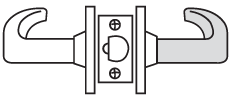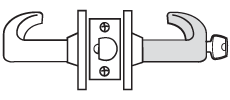Cylindrical Lock Function Guide
Cylindrical locks also known as a bored lockset is installed through the door with a knob or lever on either side that retracts the latch. The main advantage of a cylindrical lock is its relatively quick installation. Commercial Door Locks come in a variety of functions that determine how the lock operates. The American National Standards Institute (ANSI) and Builders Hardware Manufacturers Association (BHMA) have defined standards and names to over 20 functions. Below is a list of the most popular cylindrical lock functions and equal product lines across some of the most trusted commercial door hardware brands.
Non-Cylinder Functions
Passage Function

The passage function is used for doors where locking isn’t required. The lever freely operates the latch and there is no key cylinder or lock.
- ANSI Code: F75
- Latch by either lever
- Arrow CL01
- Arrow GL01
- Best 7KC N
- Best 9K N
- Corbin Russwin CL3110
- Corbin Russwin CLX3310
- Corbin Russwin CL3810
- Sargent 7U15
- Sargent 10XU15
- Sargent 11U15
- Schlage ALX10
- Schlage ND10S
- Tell LC2475
- Yale 4601LN
- Yale 4701LN
- Yale 5301LN
- Yale 5401LN
Privacy/Bed/Bathroom

The Privacy function is used for dressing rooms, bedrooms, bathrooms, or any doors that need to be locked from the inside.
- ANSI Code: F76
- Latch by either lever unless outside lever is locked from the inside
- Turning inside lever or closing door releases button
- Emergency button in outside lever unlocks
Exit

Exit locks are used for doors that only allow for exiting the door from the inside. The outside lever (if present) is rigid at all times.
-ANSI Code: F89
- Deadlocking latch
- Latch by inside lever
- The outside lever rigid at all times
- Best 7KC Y
- Best 9K Y
- Sargent 10XG13
- Sargent 11G13
- Schlage ND12
- Corbin Russwin CLX3340NT
- Tell LC2480
Dummy Trim

Dummy trims do not lock or turn and are designed to be pushed or pulled to operate a door leaf while matching the same door hardware aesthetics of the entire building or facility
- Outside/Inside Lever Rigid at all times
- Arrow RL08
- Arrow GL08
- Best 7KC 1DT
- Best 9k 01DT
- Best 9k 2DT
- Corbin Russwin CLX3350
- Corbin Russwin CLX3370
- Corbin Russwin CL3870
- Sargent 7U93
- Sargent 7U94
- Sargent 7U94-2
- Sargent 10XU93
- Sargent 10XU94
- Sargent 10XU94-2
- Sargent 11U93
- Sargent 11U94
- Sargent 11U94-2
- Schlage ALX172
- Schlage ND172
- Yale 355LN
- Yale 455LN
Single Cylinder Functions
Storeroom/Closet

Storeroom lock functions are used for storage rooms, mechanical rooms, and electrical rooms where the outside lever should be locked at all times.
-ANSI Code: F86
- Key required for entry
- Outside lever rigid at all times
- Deadlocking Latch
- Latch by lever inside or key outside
Entrance/Office

Entrance/Office function is used for offices where locking is required. Latch by either lever unless outside lever is locked from the inside
-ANSI Code: F82
- Deadlocking Latch
- Operated by key outside
- Push button released by key outside or lever inside
- Arrow CL11
- Arrow GL81
- Best 9K AB
- Corbin Russwin CLX3361
- Corbin Russwin CL3861
- Sargent 10XG24
- Sargent 11G24
- Schlage ALX50
- Schlage ND50
- Tell LC2482
- Yale 4604LN
- Yale 4704LN
- Yale 5304LN
- Yale 5404LN
Hotel/Motel

The Hotel/Motel lock function allows for entrance by key only making it perfect for Hotels, Dormitories, Apartments, and Motels.
-ANSI Code: F93
- Deadlocking latch
- Outside lever always rigid
- Inside lever operates deadbolt and latch bolt
- Deadbolt by inside thumb turn, indicator on keyed side
- Best 9K H
- Sargent 10G50
- Sargent 10XG50
- Sargent 11G50
Classroom

The classroom lock is designed to be installed in schools to prevent students from tampering with the lock. The lock is controlled by a key in the outside cylinder which locks or unlocks the outside lever
- ANSI Code: F84
- Key locks/unlock outer lever
- Deadlocking latch
- Latch by either lever unless outside lever is locked by key - Key in outside lever locks or unlocks outside lever and retracts latch
- Inside lever always operative and free
- Arrow GL87
- Arrow RL17
- Best 7KC R
- Best 9K R
- Corbin Russwin CLX3355
- Corbin Russwin CL3855
- Sargent 7G37
- Sargent 10XG37
- Sargent 11G37
- Schlage ALX70
- Schlage ND70
- Yale 4608LN
- Yale 4708LN
- Yale 5308LN
- Yale 5408LN
- Tell LC2484
Double Cylinder Functions
Apartment, Exit, Privacy

The Apartment function lockset is perfect for offices, apartment buildings, and lavatory doors. From the inside the lever acts as a privacy lock allowing free egress.
- ANSI Code: F88
- Deadlocking latch
- Latch by either lever unless outside lever is locked by key inside lever
- Key in outside lever retracts latch when outside lever is locked
- Inside lever always operative
- Best 9K C
- Corbin Russwin CLX3372
- Corbin Russwin CL3872
- Sargent 10XG16
- Sargent 11G16
- Schlage ND60
Classroom Security Intruder

The classroom security Intruder lock was designed to provide added protection against security threats in schools.
- ANSI Code: F110
- Deadlocking latch
- Latch by either lever unless key inside or outside lever is locked by key
- Key in either lever locks or unlocks outside lever
- Inside lever always operable
- Arrow GL97
- Best 9k IN
- Corbin Russwin CLX3352
- Sargent 10XG38
- Sargent 11G38
- Yale 4718LN
- Yale 5318LN
- Yale 5418LN
- Tell LC24110
Communicating

The Communicating function proves most effective in multi-exit rooms. Both levers retract the latch, while the key exclusively operates to lock or unlock its designated lever.
- ANSI Code: F80
- Deadlocking latch
- Latch by either lever
- Key in either lever locks or unlocks its own lever only
- Use only on rooms with more than one exit
- Arrow RL03
- Arrow GL03
- Corbin Russwin CLX3362
- Corbin Russwin CL3862
- Sargent 7G30
- Sargent 10XG30
- Sargent 11G30
Electromechanical Cylinder Functions
Fail Safe

The Fail Safe Function unlocks the lever when power is cut off. Power is applied to lock the door. Electrically Locked.
- Deadlocking Latch
- Key Retracts Latch
- Inside Lever always allows egress
- Power off, unlocks outside lever
- Sargent RX 10G70
- Schlage ND80EL
- Schlage ND12EL
- Schlage ND96EL
Fail Secure

The fail secure function locks when power is removed. Power is applied to unlock the door. Electrically unlocked.
- Deadlocking Latch
- Key Retracts Latch
- Inside Lever always allows egress
- Power off, unlocks outside lever
- Sargent RX 10G71
- Schlage ND80EU
- Schlage ND12EU
- Schlage ND96EU
Lock Grades
The American National Standards Institute (ANSI) and the Builders Hardware Manufacturers Association (BHMA) have established standards pertaining to the durability, strength, and overall performance of various door hardware, including locks, available in the market. The products that attain certification from ANSI/BHMA are categorized into Grade 1, Grade 2, or Grade 3 applications. These grades reflect incremental levels of performance excellence. Locks classified as Grade 1 exhibit the utmost level of strength and security. Products belonging to Grade 2 or Grade 3 also undergo specific standardized tests, but with slightly less stringent criteria. Typically, these items are utilized less frequently and in less demanding environments. Each product undergoes an array of rigorous tests, which encompass activities such as tension loading, impact and force resistance, deadbolt torque assessment, retraction deadbolt testing, pound exertion evaluations, as well as assessments of bolt or latch strength, security features, and finish durability. We exclusively offer locks that meet either Grade 1 or Grade 2 standards. Grade 3 standards are intended primarily for residential usage.
Interchangeable Cores
Cylindrical Locks have the ability to prepped for interchangeable cores. The most common you will find are a Large Format Interchangeable Core (LFIC) and Small Format Interchangeable Core (SFIC). Interchangeable cores were created to make the process of replacing the core of a lock a lot easier, eliminating the need to remove the lock itself from the door.


